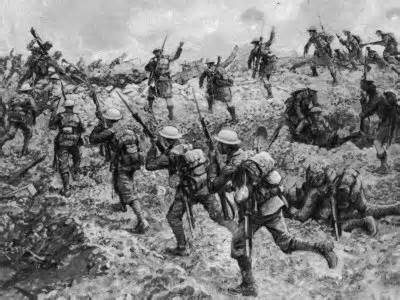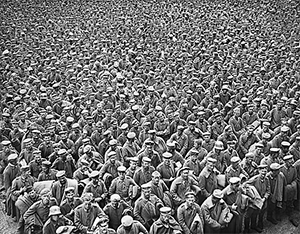The German Revolution
The German Revolution replaced an empire with a republic in the wake of the end of World War I. 
The German high command had high hopes at the beginning of the war, counting on the Schlieffen Plan to succeed, forcing France to surrender before Russia could force Germany to fight a two-front war. That success did not come, and the two sides dug trenches and attacked each other with varying degrees of intensity for four years. Time and again, German troops tried to break the stalemate, assaulting Allied positions all along the front; time and again, Allied troops attacked German fortifications—no great victory came. At best, one side claimed a few dozen miles of territory and held it for a while before giving it back as the result of a determined counterattack. 
The failure of the 1916 assault on Verdun, coupled with the staggering losses suffered at the Somme, convinced the highest of the highest in the German government to name a Chief of the General Staff: Gone was Erich von Falkenhayn, and in his place was Paul von Hindenburg (left), who made a name for himself defeating Russia in the east. Hindenburg brought with him his top subordinate, Erich Ludendorff, and the two together took over the running of the war, which had nominally been under the guidance of the emperor, Wilhelm II. From that point forward, running the war effort was the Supreme Army Command, headed by Hindenburg in name but run by Ludendorff in action. The two men committed Germany to winning a great victory, even in the face of nothing such as more trench warfare. They insisted on more men wielding more weapons; to do that, they mandated a 12-hour workday, without increasing wages or food allowances. The German government brought more and more of the country into the war, not only in manpower sent to the front to fight but also in industries mobilized to produce weapons of war. Workdays lengthened, and workers' health worsened. One consequence was a shortage of food. Failed harvests during the winter of 1916–1917 exacerbated this problem. Germany had few trading partners at this stage, and inflation was driving up the cost of goods bought internally. The winter was particularly harsh and, coupled with a lethal outbreak of influenza, led to many deaths. 
All of this uncertainty spilled into the government itself. The majority party in the Reichstag was the Social Democratic Party (SDP), which had claimed that right only in 1912. In the shadow of the Russian Revolution, in 1917, a large number of workers in Germany sought more of a life and set of opportunities than they were being offered. This was reflected in the Reichstag. The SDP splintered, into two groups. Party leader Friedrich Ebert presided over the existing gathering, which came to be called the Majority Social Democratic Party (MSPD). A significant number of SDP members, however, had had enough of the war and the emperor and left to form their own entity, the Independent Social Democratic Party (USPD), led by SDP Chairman Hugo Haase. Many people who espoused Communist beliefs lived in Germany; and, after the Communist takeover of Russia, these German revolutionaries issued calls for a similar movement in their own country. This activity intensified after Germany and Russia ratified their agreement to stop fighting each other, via the Treaty of Brest-Litovsk, on March 3, 1918. Joining the USPD were the Spartacists, members of the Spartacus League, a Marxist revolutionary movement that dated to the early days of the war. 
The Supreme Army Command had ordered a series of spring offensives, which gained some ground; however, the addition of the United States to the Allies meant a large infusion of manpower, money, and weapons, and it wasn't long until Allied forces counterattacked. The Hundred Days Offensive broke through the vaunted Hindenburg Line and then into Germany itself. The German government reorganized itself into more of a representative one, as Max von Baden took over as Chancellor and the Reichstag, the legislative body, gained command of the government and the military. Seeing the writing on the wall, the newly restructured government began negotiations to end the war. 
The war did end, on Armistice Day, November 11, at 11:00 a.m. Before that, however, the military had to contend with a revolt. In the waning days of the Allied counterattacks, German soldiers were surrendering in droves, wanting to be taken prisoner rather than killed in battle. As well, discontent spread far behind the lines. Sailors at a naval base in Kiel refused orders and made a lot of noise about the downward spiral of the war's progress. The government responded too slowly to contain the revolt, and the sentiment spread to other army and navy bases. Workers joined the soldiers and sailors in organizing against the government. In influential Bavaria, the crowds were enough to throw out the king, Ludwig III, and declare the state a socialist republic. Similar efforts prevailed in the next few days in other cities, notably Bremen, Brunswick, Chemnitz, Cologne, Dresden, Frankfurt, Hamburg,
The kaiser, the nominal head of government but no longer really an emperor, refused to enact any reforms. Seeing the discontent growing stronger, he fled to Belgium. In his place came the Council of the People's Deputies, under the leadership of Friedrich Ebert and Hugo Haase. Not all of the military was of a mind to revolt. A large contingent of soldiers marched on the Chancellory on December 6, intending to take control of the government. The coup attempt fizzled, however, in the face of soldiers' finding common ground on the streets. A similar thing occurred on December 23, when a group of soldiers who still preferred a more authoritarian form of government clashed with more republican-minded sailors at the Imperial Palace in Berlin. At one point, angry rebel sailors broke into Command Headquarters and seized the officer in charge. The Government ordered its troops to use force to put down the rebellion; a large-scale refusal to do so resulted in another avoidance of violence. Tensions seethed throughout the season of Christmas. In the new year, things calmed somewhat and a new governmental body appeared. On Jan. 19, 1919, voters elected members to a Constituent National Assembly. Familiar political parties such as the SPD and the Centre Party strove for |
|
Social Studies for Kids
copyright 2002–2026
David White





 influence, as did the new USPD and a small handful of other new parties. The SPD garnered the most seats in the new Assembly, 165 of a possible 423. To form a government, the SPD joined with the Centre Party and one of the new parties, the German Democratic Party. The National Assembly met in the Thuringian town of Weimar. Under the new governmental blueprint, which came to be known as the Weimar Constitution, a Reich President served as head of government; taking up that role was Ebert. Leading the Assembly was Prime Minister Philipp Scheidemann (left).
influence, as did the new USPD and a small handful of other new parties. The SPD garnered the most seats in the new Assembly, 165 of a possible 423. To form a government, the SPD joined with the Centre Party and one of the new parties, the German Democratic Party. The National Assembly met in the Thuringian town of Weimar. Under the new governmental blueprint, which came to be known as the Weimar Constitution, a Reich President served as head of government; taking up that role was Ebert. Leading the Assembly was Prime Minister Philipp Scheidemann (left).
